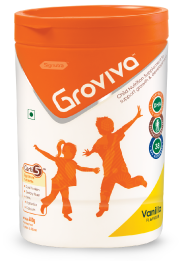
Growth and nutrition
The pre-school years are a time of rapid growth in children. At this age, the brain develops and children start developing memory and building attention skills. So, it is necessary to provide them adequate nutrition at this age and in the subsequent years for optimum growth and development.1
But, unfortunately, up to 50% children are notorious for being picky eaters that can make them miss out on important nutrients.2
Picky-eaters eat less amount of food, especially vegetables, are unwilling to try new foods, and have strong preferences for certain foods.2
First, let us understand why children are picky eaters.
As children grow up, they transition from being completely dependent on their mothers or caretakers for food to being independent, talkative beings who are strong enough to select what they like and reject what they don’t. Temper tantrums become common and parents often get frustrated!1,2
In addition to this, the trend of eating fast food is ever on the rise in children. Fast foods are tempting and children often develop a preference for it. However, these fast or junk foods have high levels of fat and sugars that are not only unhealthy but also addictive.3
Hence, picky eating and preference for fast food may cause children to miss out on foods rich in essential nutrients. This, in turn, can lead to nutrient deficiencies, impaired growth, improper brain development, compromised immunity, and underweight or even overweight!2,3,4
Nutritional requirements for growth in children

Carbohydrates:
During childhood, the need for calories is greater as children are in a period of rapid growth. They are more physically active, and have a faster metabolism compared to adults. This higher calorie requirement can be met by providing adequate amounts of carbohydrates present in a variety of fruits, vegetables, and various types of grains and cereals.5

Proteins:
Proteins supply essential amino acids required for building new tissue like muscles, and for repairing wear and tear of older tissues. Good quality protein can be obtained from fish, poultry, lean red meat, eggs, dairy products, nuts, dried beans, peas, lentils, and soy.5

Fats:
Children should consume sufficient quantities of fat, especially essential fatty acids like Docosahexaenoic acid or DHA.
DHA is required in children for normal functioning of the brain and nervous system. It also improves school performance. DHA can come from fatty fish, eggs, meat, flax seeds, walnuts, soybeans, algae, and seaweed.6,7,8
However, an excess of fat, especially animal fats, should be avoided.5

Vitamins:
Vitamins are essential for growth and development, normal body functions, and for building and maintaining the immune system.

Minerals:
All minerals are necessary for the overall growth of a child. However, two minerals namely calcium and iron are especially important. Calcium is necessary for the rapid growth of bones and for developing teeth. Iron is necessary for the formation of haemoglobin in the blood (haemoglobin transports oxygen to tissues).
Dairy products like curd and milk, legumes, and leafy vegetables are sources of calcium. Wholemeal bread, breakfast cereals, pulses, beans, peas, dried fruits, fortified cereals, and dark green vegetables, especially broccoli, contains iron.5,9

Probiotics:
Probiotics are good bacteria which support immune function and prevent harmful bacterial growth in the gut when it is disturbed by infections. They can reduce the risk and duration of diarrhoea caused by infections in children.10,11
|
Tips for managing growth and nutrition in children:
|
How can a nutritional supplement help?
Due to picky-eating, children may be consuming a less nutritious diet that is deficient in essential nutrients. To compensate for this, supplements with all essential nutrients can be given to children to boost growth and development. Research shows that children prefer drinking flavoured beverages over eating solid food; so nutrition in a beverage form would definitely be preferred.

Our nutritional supplement GrovivaTM contains 38 key nutrients along with protein, fiber, DHA, probiotics, and GrovivaTM is available in delicious vanilla and chocolate flavours that children will love to drink without any fuss! |

We suggest giving the child 1 serving of GrovivaTM, 2 levelled scoops prepared with water, twice a day, along with a balanced diet for complete nourishment and optimal growth.
References: